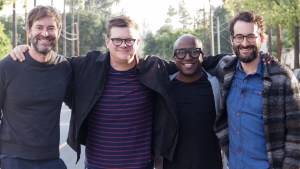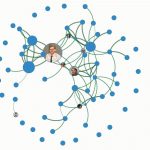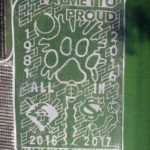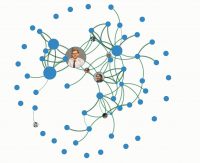How The Duplass Brothers Are Bringing Their Indie Creativity To Brands
“As our guest, take one copy on your way out,” Mark Duplass instructs me, waving his hand at a coffee table strewn with a collection of worn video cassette tape boxes showcasing a range of classic titles titles from the ’80s and ’90’s. “But do that last because you really don’t want us to know these secrets about you before we start talking.”
He grins and plops down on a sofa next to his brother and collaborator, Jay, who’s best known for his role as a Josh Pfefferman, the repentant Lothario on Transparent. I’m meeting with the siblings in the loft space of the rambling, nineteenth-century craftsman home in the Echo Park neighborhood of Los Angeles that is HQ to all things Duplass. The house dates back to 1887, when suffragettes moved in, and today still has a distinctly vintage vibe–albeit one that’s been updated with more contemporary nostalgic touches like midcentury modern chairs and VHS tapes. It is here that the New Orleans natives, who made their quirky debut with the 2005 film The Puffy Chair, churn out their numerous film and TV projects, which include films like Blue Jay, a black-and-white romantic drama starring Mark and Sarah Paulson, for Netflix; and the HBO shows Togetherness, about hipsters confronting middle age (it ran for two seasons); and their latest Room 104, an anthology series that takes place in a single motel room. The historic, three-story house, which has been carved up into editing bays and rehearsal spaces, is also now the de facto office for Donut, the digital and branded content shop that the Duplass’ recently announced with ad veterans Charlie Leahy and Nigel Lopez-McBean. The amiable British duo, who are seated across from the Duplass’ when we meet, is best known for their work on the Cannes Lion-winning spots featuring Ricky Gervais as a slacker pitchman for Optus, the telecoms company that introduced Netflix to Australia.
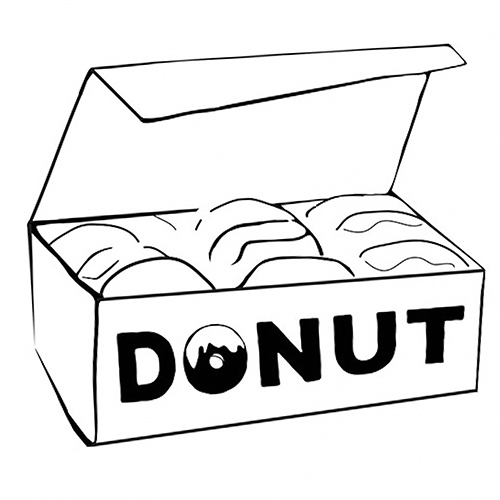
If the name Duplass and all that it implies–scrappy projects that explore the minutiae of human interactions, typically set in the hipster milieu that the brothers themselves inhabit–doesn’t seem synonymous with the sell-your-soul world of slick promotions or anything with the word “branded” in it, they’re well aware of that.
“Jay and I have been typically afraid of anything that felt like ad or branded content for a long time,” says Mark, who’s dressed in a dark blue T-shirt, jeans, and scuffed-up leather boots. “And then we met these guys”–he nods at Leahy and Lopez-McBean–“and they were working on this really cool branded content campaign with Ricky Gervais, that anti-ad thing. And we were like, this is the only thing we’ve ever seen that made us feel like we could be ourselves inside of this and got us open-minded to it. So we were like, alright, this could be really cool.”
Jay, the older and more reserved of the two, who’s sitting on the other end of the couch wearing a brightly printed shirt, says of the Gervais ad: “It was very alive and electric. You can tell they weren’t on take 37. You could feel that he was saying something that was crazy and entertaining to himself, and you can almost feel the people behind the camera almost ready to laugh. There’s like that palpable, something is happening here that is really exciting. That’s very hard to get.”
Capturing that kind of raw energy and sly, surprising performance is what Donut–which is named after the Duplass’ much-professed weakness for the carb-y treat–is all about. In many ways, the venture is a return to when “we were eight and twelve, running around with our parents’ video camera,” says Mark. “That’s something we miss a little bit.” Indeed, as Duplass Prods. has become more successful, the siblings have found themselves more removed from their comfort zone of shooting with a lean crew of friends on a microscopic budget. Working with studios and cable networks often means “you have 150 people in the room and it costs $20 million, and you can’t move,” Mark goes on. “You’re too boxed in because everybody’s scared. But when you’re a little bit nimble and you have a smaller crew and you’re truly collaborating, then you can be on your feet to move around and find magic.”
The basic premise behind Donut is to partner with brands and apply the Duplassian aesthetic, which they dub “epically small,” to short-form storytelling. At this point there are few specifics as to what this will look like, exactly, but the Donut guys talk about everything from narrative and documentary-style video series to more traditional spots to making original content for platforms like Snapchat and Facebook, which is venturing into online TV next month. (As of yet no deals have been announced with those platforms, but the brothers don’t deny they are being courted.) The company’s first campaign will be for Amazon Echo and will launch later this summer. Sean Ohlenkamp, creative director for Amazon’s in-house creative agency D1, says the company chose to work with Donut because “Mark and Jay capture that human condition that we can all relate to. They capture how messy life really is. A lot of other people just try to polish and perfect it and water it down.”
This resonates with Amazon, which believes in “putting the customer first and focussing on people,” Ohlenkamp says. “Our customers are not polishing their lives when they’re putting it out for the world to see. We can see that through their use of different social platforms. So it’s important to us that we speak to our customers the way they’re speaking to each other.”
Backing up the Duplass’ artistic chops are Leahy and Lopez-McBean’s marketing and digital savvy. Having worked for brands like Harley-Davidson, Honda, Citibank and Emotive, Leahy says, “We come at it with a knowledge and a strategy around distribution and amplification because that’s really the world we live in. Yes, you can make something awesome and put it out there, but unless you know who you’re going to drive it to, who’s going to watch it, where they’re going to watch it, and how to create different styles of it and types of content for different platforms–there’s two sides to the coin.”
The Donut partners feel that this combined synergy–indie art mixed with “the dark arts of social video,” as Leahy jokes–makes the company a unique proposition in a world where brands are desperately trying to engage with fickle audiences who don’t want to feel like they’re being sold to. It’s also a world where once novel tactics like hiring digital influencers to spread the word in an organic-feeling way, are starting to feel hackneyed.
“For the first time people are questioning the fact that just because you spent $5 million on a major influencer, is someone going to go out and buy your widget?,” says Mark. “Nobody wants to say it, but they’re all like, this may not be working, and this may not be as easy as we thought.”
“And that gives us confidence, at least for what we feel we have to offer,” Mark continues. “Because we can tell you just an everyday story, really well-told, that’s about core basic issues that can relate to you. We’re less good at being like, guys, we got LeBron James and let’s get it! We’re more interested in, we’ve actually got LeBron James’ third cousin who might have been good [at basketball] but got injured in high school. That’s a better story for us. And that’s where we feel brands are heading. It’s cheaper for them to make. It’s a little less risky. It’s a little more human. That’s kind of, like, where we fit.”
1. Creativity Based In Limits
Donut’s creative approach mimics the way the Duplass’ work as indie filmmakers, a philosophy that Mark describes as “creativity based in limits.”
“It’s something we’ve come to embrace through the years, because we kind of came up making $5 movies, and we would literally throw things on the table and say, what do we have available to us? How can we make a movie out of this? Our first feature film, The Puffy Chair, was built that exact way. We have $10,000 to make a movie, so we have Mark’s van, we have these two apartments…
“There are the two actors who are willing to waste three weeks with us,” Jay adds, smiling.
“We can get doubles of this one, disgusting recliner for $500, let’s write those in,” Mark goes on. “And then you back into that thing, and there’s something very inspiring about that. And to that end, you know, working with brands and stuff, a lot of times they’ll come to us and say, ‘Here’s a need. Here is a quote unquote limit. Here is something we have to work with.’ And then Jay and I look at that the same way we look at our independent films, and we just back right into that thing. And not only is that really fun for us, but in this case, when you get to do it with a brand, we don’t have to pay for it ourselves. It’s funded. It’s sustainable. So that’s part of the allure for us.”
Their crew is also limited, generally taking the form of a group of fellow indie filmmakers and friends who take on multiple jobs. Beyond being economical, a smaller team allows the filmmakers to work fluidly and create a more natural, human feeling on set.
“Everyone who’s been on a set knows that a set is the most constructed, fake thing in the world,” says Jay. “And we’ve spent our whole careers breaking that down so we can really experience that moment.”
“We’re at our best when we’re with a small group of trusted collaborators that’s functioning as this faux family,” says Mark. “Through the years we’ve realized that, as were producing for all these young filmmakers, we kind of have a little stable. It almost feels like what Roger Corman was doing in the 1970’s, but you know we don’t make movies with octopuses, we make movies with feelings.”
This lean and mean style is unusual in advertising and Lopez-McBean says it takes some explaining. “They sit around and go, how are these guys doing this for this? Even down to the way they shoot, we have to spend a lot of time liaising with the partners, saying, ‘I know this looks really weird and it’s not what you’re used to, but trust me, this works really well.”
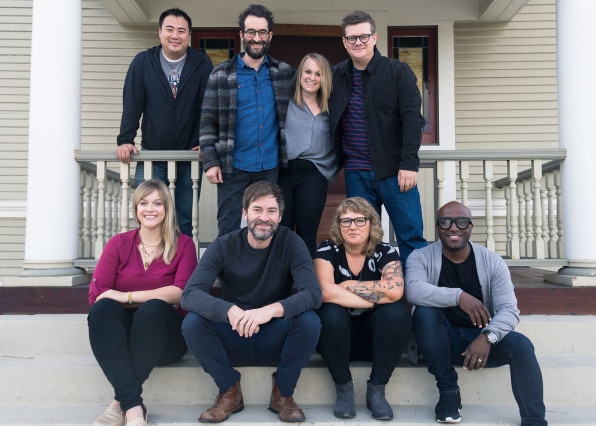
2. Spread The Risk Around
The Duplass’ borderline abhorrence to making projects for a lot of money has led them to make deals in which budgets are spread around on multiple projects. For example: their four-picture deal with Netflix. The idea is to not put all the eggs in one basket, a move that minimizes creative and financial risk, and allows the brothers to feel more experimental freedom. If one doesn’t work, oh well. Another one might. With Donut, they’re taking this approach to brands, preferring to experiment on a few spots or videos and see which one resonates, as opposed to focusing on one, big effort.
“In the Hollywood filmmaking model, there’s creative hubris that matches what we’ve seen in the ad world, which is, ‘We think this is going to be the best spot–let’s spend our money on it,’” says Mark. “You go there, maybe it works, maybe it doesn’t. And a lot of times it doesn’t, and then you’re stuck. Our model is, nobody knows anything. So what you need to do is make a lot of things cheaply upfront, and be able to chase that creative. So what we’re offering a lot of people is, hey, rather than spending X on one spot, let’s spend X on five or six smaller versions, and then we’ll start testing them and seeing what works. We thought it was going to be that spot with that star, but it’s actually that average dude that we found at a casting call who’s just hilarious and killing it, so let’s make a whole campaign around that before you blow your money guessing what was going to hit.”
“That’s what our Netflix model was based on, honestly,” Mark continues. “We’re not gonna make you one movie–we’re gonna make you four little ones. And we’ll let the zeitgeist decide what blows up. And that humility has helped us as creators and seems to be lacking almost everywhere, honestly.”
“That’s not to say the guys in the agency world don’t test everything they create,” says Leahy. “Of course they do. That’s part of that world. But our model allows you to chase that creativity from the inside and start seeing those results in a far quicker form and get stuff out at a far quicker rate.”
3. Get Back To Basics
Making shorter, cheaper content is allowing the Duplass’ to explore new formats, like documentaries, and pursue projects that are either too labor or time-intensive in the feature film and TV worlds. Meanwhile, as the appetite for this kind of content grows on platforms like Snapchat, Facebook, and even Apple, there are opportunities to produce original content even without a brand affiliation. The Donut execs say they see all of it as ways to push creative boundaries.
“There are scenarios that we’re talking about that return Mark and me to our Sundance days, where it’s literally me shooting Mark on a boom,” says Jay. “There’s some fun stuff we’re talking about.”
“One form that’s really exciting for us is docs,” adds Mark. “Jay and I have been documentary fans forever. It’s all we watch. But we don’t really embark on making feature documentaries because, quite frankly, it takes seven years–you have to leave your family and you go broke. But when you’re doing it for a brand, it’s a shorter shoot, it’s a targeted shoot. It’s more of a crafted, written doc, but there’s still that element of discovery where you may be flying to Malaysia to interview this fisherman who’s been doing the thing for years and years and you learn about that world. And Jay and I can get into what I call Maisel Bros. mode, where it’s kind of like the two of us and a small crew where we use the skills we’ve developed in narrative filmmaking, where your subject trusts you and you build a rapport with them. We really haven’t directed documentaries together and we’re going to get to do a lot of that in this space.”
“At that very expensive, crazy high level [of production], you stop making art with your hands and you start having a thousand conversations about art,” says Jay. “A million conversations. Everyone’s needling every little thing. And the more that we get back to making stuff as brothers, just making stuff with our friends and finding beautiful things where you might not expect it–that’s kind of like the dream.”
Mark and Jay Duplass’ new venture Donut is a creative agency built around their aesthetic of “epically small,” i.e. low budget, high-impact.
“As our guest, take one copy on your way out,” Mark Duplass instructs me, waving his hand at a coffee table strewn with a collection of worn video cassette tape boxes showcasing a range of classic titles titles from the ’80s and ’90’s. “But do that last because you really don’t want us to know these secrets about you before we start talking.”
Fast Company , Read Full Story
(55)

